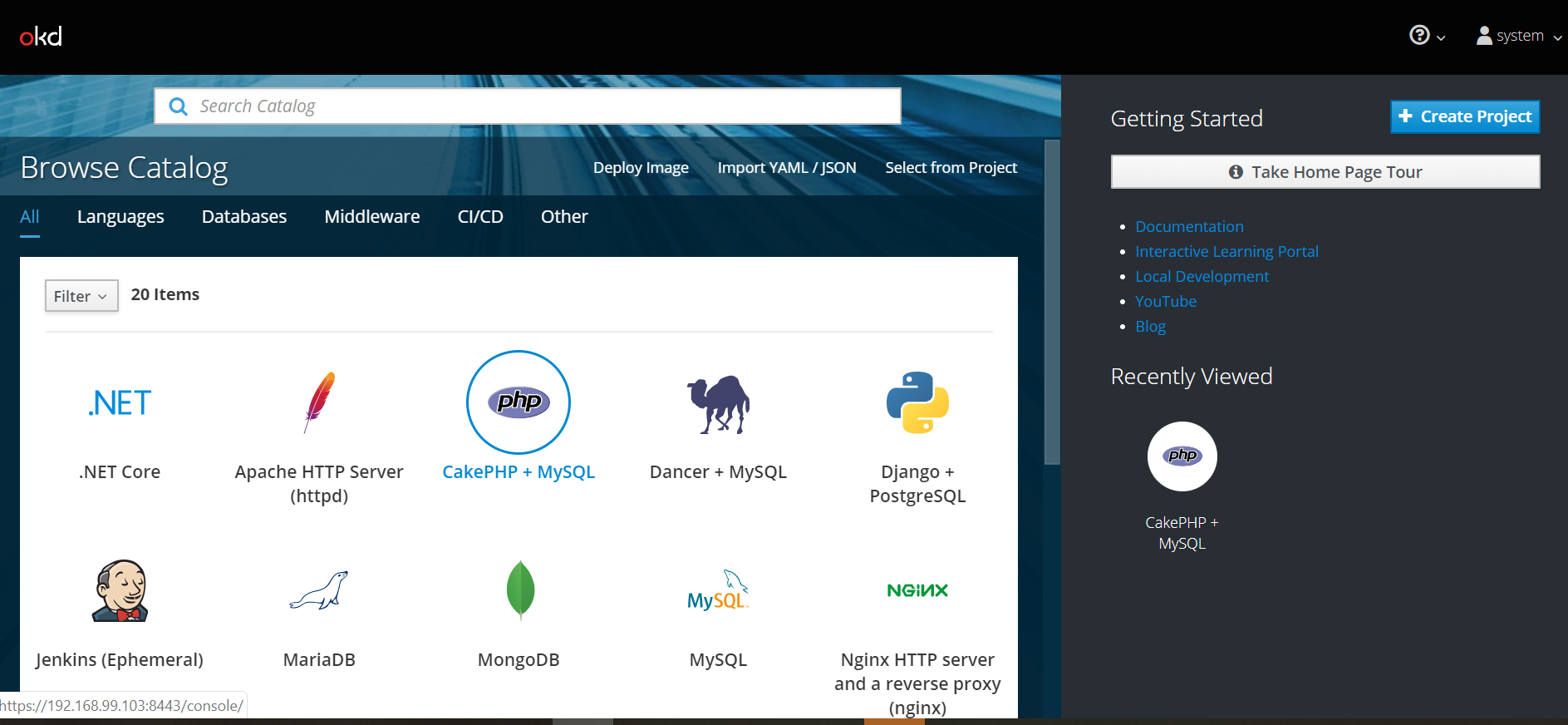Develop On Openshift on your Windows 10 Laptop
As part of our Work we install and configure Openshift. We offer full solutions from installation through the Devops pipeline.

I have found that using minishift with VirtualBox to be the easiest Proof of Concept as well as the ability to develop applications and Infrastructure as a service. I found it easiest to fiddle with OKD to be able to simply create projects for R & D.
Install Oracle Virtual box
Download Minishift
https://docs.okd.io/latest/minishift/getting-started/preparing-to-install.html
download the Windows AMD 64 latest, It works with Intel also, from https://github.com/minishift/minishift/releases
Now run the minishift with your previously installed VirtualBox
Run:
.\minishift start –vm-driver=virtualbox
You Should see output similar to the following:
PS C:\Users\Steve\Downloads\minishift-1.34.0-windows-amd64\minishift-1.34.0-windows-amd64> .\minishift start –vm-driver=virtualbox
— Starting profile ‘minishift’
— Check if deprecated options are used … OK
— Checking if https://github.com is reachable … OK
— Checking if requested OpenShift version ‘v3.11.0’ is valid … OK
— Checking if requested OpenShift version ‘v3.11.0’ is supported … OK
— Checking if requested hypervisor ‘virtualbox’ is supported on this platform … OK
— Checking if VirtualBox is installed … OK
— Checking the ISO URL … OK
— Checking if provided oc flags are supported … OK
— Starting the OpenShift cluster using ‘virtualbox’ hypervisor …
— Minishift VM will be configured with …
Memory: 4 GB
vCPUs : 2
Disk size: 20 GB
— Starting Minishift VM …………………………………………………………. OK
— Checking for IP address … OK
— Checking for nameservers … OK
— Checking if external host is reachable from the Minishift VM …
Pinging 8.8.8.8 … OK
— Checking HTTP connectivity from the VM …
Retrieving http://minishift.io/index.html … OK
— Checking if persistent storage volume is mounted … OK
— Checking available disk space … 1% used OK
— Writing current configuration for static assignment of IP address … OK
Importing ‘openshift/origin-control-plane:v3.11.0’ . CACHE MISS
Importing ‘openshift/origin-docker-registry:v3.11.0’ . CACHE MISS
Importing ‘openshift/origin-haproxy-router:v3.11.0’ . CACHE MISS
— OpenShift cluster will be configured with …
Version: v3.11.0
— Pulling the OpenShift Container Image ………………………………………………… OK
— Copying oc binary from the OpenShift container image to VM … OK
— Starting OpenShift cluster ………………………………………………………………………………………..
Getting a Docker client …
Checking if image openshift/origin-control-plane:v3.11.0 is available …
Pulling image openshift/origin-cli:v3.11.0
E0610 11:41:17.513088 5298 helper.go:173] Reading docker config from /home/docker/.docker/config.json failed: open /home/docker/.docker/config.json: no such file or directory, will attempt to pull image docker.io/openshift/origin-cli:v3.11.0 anonymously
Image pull complete
Pulling image openshift/origin-node:v3.11.0
E0610 11:41:21.932429 5298 helper.go:173] Reading docker config from /home/docker/.docker/config.json failed: open /home/docker/.docker/config.json: no such file or directory, will attempt to pull image docker.io/openshift/origin-node:v3.11.0 anonymously
Pulled 5/6 layers, 84% complete
Pulled 5/6 layers, 91% complete
Pulled 5/6 layers, 99% complete
Pulled 6/6 layers, 100% complete
Extracting
Image pull complete
Checking type of volume mount …
Determining server IP …
Using public hostname IP 192.168.99.103 as the host IP
Checking if OpenShift is already running …
Checking for supported Docker version (=>1.22) …
Checking if insecured registry is configured properly in Docker …
Checking if required ports are available …
Checking if OpenShift client is configured properly …
Checking if image openshift/origin-control-plane:v3.11.0 is available …
I0610 11:42:46.592821 5298 config.go:40] Running “create-master-config”
Starting OpenShift using openshift/origin-control-plane:v3.11.0 …
I0610 11:42:49.362781 5298 config.go:46] Running “create-node-config”
I0610 11:42:50.221651 5298 flags.go:30] Running “create-kubelet-flags”
I0610 11:42:50.658843 5298 run_kubelet.go:49] Running “start-kubelet”
I0610 11:42:50.868437 5298 run_self_hosted.go:181] Waiting for the kube-apiserver to be ready …
I0610 11:45:21.887333 5298 interface.go:26] Installing “kube-proxy” …
I0610 11:45:21.887370 5298 interface.go:26] Installing “kube-dns” …
I0610 11:45:21.887380 5298 interface.go:26] Installing “openshift-service-cert-signer-operator” …
I0610 11:45:21.887406 5298 interface.go:26] Installing “openshift-apiserver” …
I0610 11:45:21.887442 5298 apply_template.go:81] Installing “openshift-apiserver”
I0610 11:45:21.887668 5298 apply_template.go:81] Installing “kube-proxy”
I0610 11:45:21.889130 5298 apply_template.go:81] Installing “kube-dns”
I0610 11:45:21.889388 5298 apply_template.go:81] Installing “openshift-service-cert-signer-operator”
I0610 11:45:29.205152 5298 interface.go:41] Finished installing “kube-proxy” “kube-dns” “openshift-service-cert-signer-operator” “openshift-apiserver”
I0610 11:49:14.230117 5298 run_self_hosted.go:242] openshift-apiserver available
I0610 11:49:14.230787 5298 interface.go:26] Installing “openshift-controller-manager” …
I0610 11:49:14.230810 5298 apply_template.go:81] Installing “openshift-controller-manager”
I0610 11:49:18.117466 5298 interface.go:41] Finished installing “openshift-controller-manager”
Adding default OAuthClient redirect URIs …
Adding centos-imagestreams …
Adding registry …
Adding router …
Adding web-console …
Adding sample-templates …
Adding persistent-volumes …
I0610 11:49:18.140199 5298 interface.go:26] Installing “centos-imagestreams” …
I0610 11:49:18.140207 5298 interface.go:26] Installing “openshift-image-registry” …
I0610 11:49:18.140213 5298 interface.go:26] Installing “openshift-router” …
I0610 11:49:18.140220 5298 interface.go:26] Installing “openshift-web-console-operator” …
I0610 11:49:18.140225 5298 interface.go:26] Installing “sample-templates” …
I0610 11:49:18.140230 5298 interface.go:26] Installing “persistent-volumes” …
I0610 11:49:18.140643 5298 apply_list.go:67] Installing “centos-imagestreams”
I0610 11:49:18.141507 5298 apply_template.go:81] Installing “openshift-web-console-operator”
I0610 11:49:18.141649 5298 interface.go:26] Installing “sample-templates/mongodb” …
I0610 11:49:18.141657 5298 interface.go:26] Installing “sample-templates/cakephp quickstart” …
I0610 11:49:18.141663 5298 interface.go:26] Installing “sample-templates/sample pipeline” …
I0610 11:49:18.141668 5298 interface.go:26] Installing “sample-templates/mariadb” …
I0610 11:49:18.141673 5298 interface.go:26] Installing “sample-templates/mysql” …
I0610 11:49:18.141678 5298 interface.go:26] Installing “sample-templates/postgresql” …
I0610 11:49:18.141683 5298 interface.go:26] Installing “sample-templates/dancer quickstart” …
I0610 11:49:18.141689 5298 interface.go:26] Installing “sample-templates/django quickstart” …
I0610 11:49:18.141696 5298 interface.go:26] Installing “sample-templates/nodejs quickstart” …
I0610 11:49:18.141702 5298 interface.go:26] Installing “sample-templates/rails quickstart” …
I0610 11:49:18.141708 5298 interface.go:26] Installing “sample-templates/jenkins pipeline ephemeral” …
I0610 11:49:18.141737 5298 apply_list.go:67] Installing “sample-templates/jenkins pipeline ephemeral”
I0610 11:49:18.141905 5298 apply_list.go:67] Installing “sample-templates/mongodb”
I0610 11:49:18.142001 5298 apply_list.go:67] Installing “sample-templates/cakephp quickstart”
I0610 11:49:18.142090 5298 apply_list.go:67] Installing “sample-templates/sample pipeline”
I0610 11:49:18.142170 5298 apply_list.go:67] Installing “sample-templates/mariadb”
I0610 11:49:18.142251 5298 apply_list.go:67] Installing “sample-templates/mysql”
I0610 11:49:18.142370 5298 apply_list.go:67] Installing “sample-templates/postgresql”
I0610 11:49:18.142457 5298 apply_list.go:67] Installing “sample-templates/dancer quickstart”
I0610 11:49:18.142535 5298 apply_list.go:67] Installing “sample-templates/django quickstart”
I0610 11:49:18.142616 5298 apply_list.go:67] Installing “sample-templates/nodejs quickstart”
I0610 11:49:18.142697 5298 apply_list.go:67] Installing “sample-templates/rails quickstart”
I0610 11:49:33.183109 5298 interface.go:41] Finished installing “sample-templates/mongodb” “sample-templates/cakephp quickstart” “sample-templates/sample pipeline” “sample-templates/mariadb” “sample-templates/mysql” “sample-templates/postgresql” “sample-templates/dancer quickstart” “sample-templates/django quickstart” “sample-templates/nodejs quickstart” “sample-templates/rails quickstart” “sample-templates/jenkins pipeline ephemeral”
I0610 11:52:04.653231 5298 interface.go:41] Finished installing “centos-imagestreams” “openshift-image-registry” “openshift-router” “openshift-web-console-operator” “sample-templates” “persistent-volumes”
Login to server …
Creating initial project “myproject” …
Server Information …
OpenShift server started.The server is accessible via web console at:
https://192.168.99.103:8443/consoleYou are logged in as:
User: developer
Password: <any value>To login as administrator:
oc login -u system:admin— Exporting of OpenShift images is occuring in background process with pid 11844.
You can now create project via the GUI from:
https://YOUR_IP_ADDRESS:8443/console
You can create Openshift projects and even open the Openshift GUI in your broswer:

As instructed login to the GUI with user system and password admin
In order to be able to create projects from the CLI, you need the oc and kubectl execubles.
Run:
minishift oc-env
This will show you something like
PS C:\Users\Steve\Downloads\minishift-1.34.0-windows-amd64\minishift-1.34.0-windows-amd64> .\minishift.exe oc-env
$Env:PATH = “C:\Users\Steve\.minishift\cache\oc\v3.11.0\windows;$Env:PATH”
# Run this command to configure your shell:
# & minishift oc-env | Invoke-Expression
PS C:\Users\Steve\Downloads\minishift-1.34.0-windows-amd64\minishift-1.34.0-windows-amd64>
You can also download the exectubles and be able to run any Openshift project that you have access to.
Then run as it says:
& minishift oc-env | Invoke-Expression
Now you should be able to run the oc and kubectl commands which are central to Openshift.
Download Openshift OC and minikube windows exectubles
You can open them and run a powershell from that dir, even add it to your path
When the installation gets stuck you can run
.\minishift.exe delete
https://docs.okd.io/latest/minishift/getting-started/uninstalling.html
From within a Centos 7 VM, after installing docker you can run Openshift Origin in a VM
To get started I ran the following command. Next time for security I will get it to run NOT as root, but this will do for now as POC Proof of Concept
sudo docker run -d –name “origin” –privileged –pid=host –net=host -v /:/rootfs:ro -v /var/run:/var/run:rw -v /sys:/sys -v /sys/fs/cgroup:/sys/fs/cgroup:rw -v /var/lib/docker:/var/lib/docker:rw -v /var/lib/origin/openshift.local.volumes:/var/lib/origin/openshift.local.volumes:rslave openshift/origin start
This is formerly called Origin
sudo docker run -d –name “origin” \ –privileged –pid=host –net=host \ -v /:/rootfs:ro -v /var/run:/var/run:rw -v /sys:/sys -v /sys/fs/cgroup:/sys/fs/cgroup:rw \ -v /var/lib/docker:/var/lib/docker:rw \ -v /var/lib/origin/openshift.local.volumes:/var/lib/origin/openshift.local.volumes:rslave \ openshift/origin start
To use only Virtualbox as your VM run:
.\minishift.exe config set vm-driver virtualbox
Source: Setting Up a Cluster | Getting Started | OKD 3.11
Also see: https://docs.okd.io/latest/minishift/index.html
